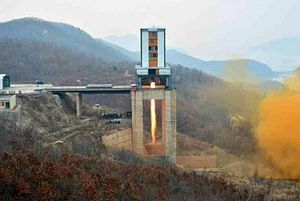On Monday, Joseph S. Bermudez Jr. at 38 North published a series of new satellite images taken in July of North Korea’s Sohae Satellite Launching Station that show dismantlement activity around at least two facilities there.
The images show changes to a staging, or processing, building near the rocket launch gantry used by North Korea for its space launch vehicles (SLVs); this building is used to assemble SLVs.
Separately, North Korea has dismantled part of the static liquid-propellant engine vertical testing stand — a concession promised by Kim Jong Un to U.S. President Donald J. Trump at the June 12 summit meeting in Singapore. (Trump claimed he asked Kim to dismantle the test stand, but subsequent reporting made clear that this concession was likely prepared by North Korea.)
Both developments are a positive sign of momentum in the post-Singapore diplomatic process between the United States and North Korea, which has seen its fair share of turbulence recently. Notably, U.S. Secretary of State Mike Pompeo’s trip to Pyongyang earlier this month did not go particularly well, with North Korea chiding him after-the-fact for making unilateral disarmament demands during talks.
Nevertheless, the imagery shows that North Korea began its dismantlement activity following Pompeo’s trip, suggesting that there may have been an unpublicized agreement between the two sides. If North Korea had prepared the offer concerning the engine test stand at Sohae for Singapore, it likely had an ask in mind to follow through.
A U.S. concession isn’t immediately apparent; the dismantlement activity has coincided, to the contrary, with stepped up calls by the United States for UN Security Council sanctions enforcement. On Monday, the U.S. Department of the Treasury published an additional North Korea-focused sanctions enforcement advisory, too.
For now, the activity ongoing at Sohae will have diplomatic and political value. It will likely provide enough momentum to keep the post-Singapore implementation talks and working group-level talks between the United States and North Korea on track. For Pompeo and Trump, the concession will also serve as evidence that North Korea is submitting to a process of “denuclearization.”
An initial technical impression suggests that this sort of an assessment might be premature. The missile engine test stand — the long-awaited concession after June 12 — appears to be in a mostly reversible state.
Critically, the concrete foundation pillars remain in place; only the metal superstructure, which accommodates the test engine units, has been dismantled. This would appear to leave the site in a relatively “reversible” state of dismantlement. (Without ground-level access for expert inspectors, verification will be difficult.)
The disassembly of the SLV processing building is more interesting. What this does is presumably grant imagery analysts — both those working in the U.S. and other intelligence communities and open source analysts — a degree of transparency regarding any potential preparatory work at Sohae for a new SLV launch. North Korea isn’t expected to imminently launch a new SLV, but reports from 2017 have hinted at a new-generation North Korean SLV in the works.
Ultimately, however, both of these concessions could have limited value in limiting North Korea’s arsenal; that’s where a verifiable freeze on the country’s missile manufacturing plants and enrichment sites is necessary.
North Korea, for instance, may no longer be looking to conduct additional static tests of its large liquid-propellant engines, like its indigenous variant of the RD-250 engines used in the Hwasong-12, Hwasong-14, and Hwasong-15 missiles. Its engineers may be satisfied with the developmental data they gleaned from the limited static engine tests conducted at the Sohae site and the additional data gained from flight-testing. (Together, the three missiles incorporating RD-250-variant engines flew nine times in 2017, with three failures of the Hwasong-12.)
With regard to the SLV program, it’s not clear that North Korea would continue to rely on the Sohae site. While the infrastructure there is well-developed — including an impressive mission control room — Pyongyang could take the unconventional, but not unheard of step of moving to using mobile transporter-erector-launchers for a new-generation SLV. (Some of Israel’s Shavit SLVs used this configuration.)
In the coming days, it’ll be worth waiting for any official North Korean state media treatment of these concessions. All we’d heard about potential concessions coming out of Sohae had come from the United States’ side; North Korea’s been quiet about the matter.

































